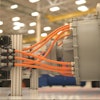
Ray Enger, USON Director of Engineering, www.uson.com
When was the last time you bought software, equipment, or instruments that weren’t touted by the manufacturer as user-friendly? “Not in memory” would be my answer.
As a fellow engineer tasked with new product design and development, the next question is, “Was there ever a time when user-friendly was not a design standard to achieve?” Again, not in memory.
That probably goes a long way in explaining the obvious: most computers, software, equipment, and instruments really are, by any objective measure, far easier to use than those you’d find decades ago (when I first started out my engineering career). Graphically intuitive interfaces geared for even lightly skilled workers are ubiquitous, but that doesn’t stop us from reaching for a far higher bar in defining “user friendly” at USON. I imagine it doesn’t stop you either.
In my view, the newer divide for “user-friendly” in instrumentation is the extent to which complexity for higher level programming is handled by behind the scenes control software. On a practical level, this means that more highly trained engineers who otherwise need to expend a good deal of time (and effort) configuring instrumentation for application requirements have something closer to plug-and-play.
For example, a newer model leak tester that USON had in development for three years, the Optima vT Leak and Flow Tester, is so configurable that its limits are practically not finitely bound. For example, it can do a dozen different types of NDT tests (differential pressure decay, downstream cracking pressure, burst tests, laminar flow, etc.) in any combination or sequence.
Do some quick math and you realize we are talking about more than half a billion possible permutations of test sequences handled by two channels, each with four sensors, totaling up to 8 sensor inputs. The pneumatics, which are vital in any leak testing equipment, are completely configurable in this model — it’s also why it has a ‘V’ in its name, for versatility.
All of that versatility could easily pose a nightmare for the manufacturing engineer charged with setting it up in a production line if user-friendly was limited to a nice graphical interface that only indicated red=fail and green=pass. Instead, the operator interface walks the engineer through set-up screens. In one or two minutes, it can be entirely set-up or re-configured if tweaks are desired to drive higher throughputs while maintaining gage R&R.
We have no doubt that the quality and manufacturing engineers have the intellectual capacity to program test sequences the slower, more manual way. We know that they do not have the time and they don’t live and breathe leak-testing, like we do 24/7. (We do sleep, but that is how it feels.) We understand the minutiae of how to set up test cycles for accuracy and speed.
Our product development team defines “user-friendly” with a director of engineering, such as me, in mind. With so much on my plate, the last thing I want to do is devote days or weeks to programming and optimizing every piece of equipment used in our operation.
For most engineers, and most managers in any department, time management is the beast to be tamed. An instrument is not user-friendly if it eats up your day, period.
Yes, our Optima vT user interface is handsome and intuitive, but it’s the brain power within it that enables rapid and detailed set-up and configuration for any particular application requirements. It’s the front-end design that really gives it a circa 2012 definition of user-friendly.
Ray Enger is Director of Engineering for USON (www.uson.com), which first developed high accuracy leak testing methods for NASA and since 1963 has been at the forefront, of leak detection, leak testing, and non-destructive testing — pioneering the development of automated leak detection equipment for the automotive, industrial, medical device and packaging industries. Enger can be reached at[email protected], and at 281-671-2000.






















